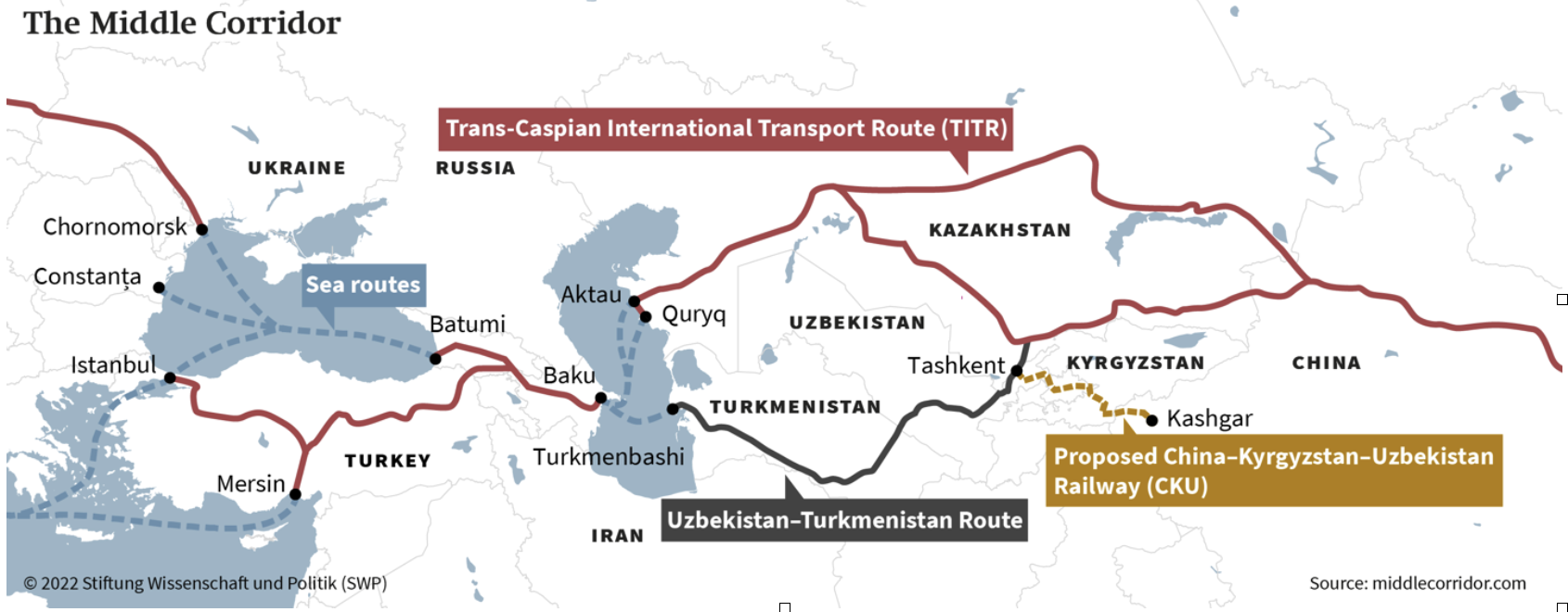European and International Financial Institutions to Invest $10 Billion in the Middle Corridor
Recent Articles
Author: Toghrul Ali
02/01/2024
The Global Gateway Investors Forum for EU-Central Asia Transport Connectivity convened January 29-30 in Brussels, uniting high-level representatives, financial institutions, and the private sector from the European Union Member States, Central Asia, South Caucasus, and Türkiye. On the first day of the event, European Commission (EC) Executive Vice President Valdis Dombrovskis announced that European and international financial institutions have pledged to invest €10 billion (approximately $10.8 billion) to develop sustainable transport connectivity in Central Asia. The pledged investment is expected to be allocated towards the development of the Middle Corridor, also known as the Trans-Caspian International Route (TITR). The ongoing conflict in Ukraine has spurred the EU to explore alternative trade routes that bypass Russia, amplifying the significance of the Middle Corridor. To fully optimize its potential, further infrastructure improvements are imperative. The pledged investments from European institutions present an historic opportunity to realize this vision.
The Middle Corridor is a multimodal land and sea transport corridor, helping products move from as far east as China to Europe through Kazakhstan, Uzbekistan, Turkmenistan, Azerbaijan, Türkiye, and across the Black and Caspian Seas. Historically, Europe has relied on the Northern Corridor, a route that transports products from China, through Russia, to European consumer markets. With its total length 2,000 kilometers shorter than Russia’s Northern Corridor, the Middle Corridor has the potential to become a viable alternative by shortening the transport duration to 15 days.
 As a part of the €10 billion investment package, several important memoranda of understanding (MoU) were signed between European financial institutions and Central Asian governments. The European Investment Bank (EIB) signed MoUs with Kazakhstan, Kyrgyzstan, Uzbekistan, and the Development Bank of Kazakhstan to invest €1.47 billion (approximately $1.6 billion) to develop transport connectivity between Europe and Central Asia. Similarly, the European Bank for Reconstruction and Development (EBRD) signed a MoU with Kazakhstan to invest €1.5 billion in ongoing connectivity projects. The EU is also planning to provide twinning and technical assistance to Central Asian countries in developing the route. According to EC’s Vice President Margaritis Schinas, “Senior resident twinning advisors from our EU Member States will be assigned to all Central Asian countries,” along with a coordination platform that will monitor the progress.
As a part of the €10 billion investment package, several important memoranda of understanding (MoU) were signed between European financial institutions and Central Asian governments. The European Investment Bank (EIB) signed MoUs with Kazakhstan, Kyrgyzstan, Uzbekistan, and the Development Bank of Kazakhstan to invest €1.47 billion (approximately $1.6 billion) to develop transport connectivity between Europe and Central Asia. Similarly, the European Bank for Reconstruction and Development (EBRD) signed a MoU with Kazakhstan to invest €1.5 billion in ongoing connectivity projects. The EU is also planning to provide twinning and technical assistance to Central Asian countries in developing the route. According to EC’s Vice President Margaritis Schinas, “Senior resident twinning advisors from our EU Member States will be assigned to all Central Asian countries,” along with a coordination platform that will monitor the progress.
Over the past years, the EU has noticeably increased its cooperation with the region. The European bloc remains the largest source of foreign direct investments (FDI) in the region, in addition to being the second largest trading partner of Central Asian countries. In his remarks, Dombrovskis stressed that the EU remains a “strong, committed and reliable partner” for Central Asia. He mentioned that transport connectivity plays a central role in the EU-Central Asia partnership. To this end, it was emphasized that the long-term objective is to transform the Middle Corridor into a “multimodal, competitive, sustainable, smart and fast route to link our two regions in 15 days or less.”
Increased attention to the Middle Corridor has also brought attention to some of the challenges the route currently faces. According to Kazakhstan’s Minister of Transportation, Marat Karabayev, the volume of cargo transportation via the Middle Corridor reached 2.8 million tons by the end of 2023, up from 1.5 million tons in the previous year. Given its currently limited capacity, further infrastructure and other developments are necessary to prevent bottlenecks along the route. Improvements in customs procedures, cargo and port capacity, security, and streamlining are needed to optimize the effectiveness of the Middle Corridor. Plans call for increasing the volumes of cargo transiting the Middle Corridor to 11 million tons annually by 2030. Investments from outside key actors such as the EU can provide the necessary capital, as well as the technical know-how to realize these goals.
Commenting on the Forum’s outcomes and future trajectory of the investments pledged, member of the Caspian Policy Center’s (CPC) Board of Directors and former U.S. Ambassador to Tajikistan and to Kazakhstan, Richard Hoagland, described the EU’s willingness to invest in the region as a “truly positive, even historic development.” Hoagland emphasized the importance of establishing some form of coordination, even if temporary or ad hoc, to coordinate the allocation of funds from various banking sources. “Otherwise, there is a danger that ‘special interests’ that are rampant in the region will press hard for projects that might benefit the few but that would not necessarily grow the Middle Corridor,” he added.
The Investors Forum was an important testament to the EU’s relations not only with Central Asia, but also with the whole Caspian region. When asked about the significance of the Forum, member of the CPC Board of Directors and former British Ambassador to Kazakhstan, David Moran, said: “The Investors Forum commitments will inject new momentum into the development of regional transport connectivity...the interest of private investors is clear - there are plenty of challenges and obstacles to overcome, but the Forum's outcomes mark a promising start to 2024.”